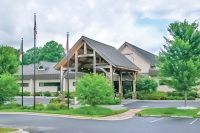Lack of shelters leaves transit riders out in the cold
 For the elderly, disabled and carless residents of Haywood County, the public transit bus is an indispensable resource that keeps them mobile.
For the elderly, disabled and carless residents of Haywood County, the public transit bus is an indispensable resource that keeps them mobile.
But, it doesn’t run on a set schedule. Much like a taxi service, the bus works on an on-demand basis. People looking to hitch a ride must call in advance and then they are given a two-hour window during which the bus will pick them up — from their home, the doctor or the store.
In the meantime, they may be left holding their shopping bags outside while they wait, usually without anywhere to rest. Many popular pick-up points don’t provide benches or shelters.
“It takes us a little time to get to them. That leaves them there stranding with bags or standing with a cart,” said Susan Anderson, director of Mountain Projects, a nonprofit that serves the elderly, disadvantaged and general public in Western North Carolina. Mountain Projects runs the transit system.
“It is really difficult for (the elderly and disabled) to stand outside a store for 15 minutes or more,” she said.
Anderson will address Waynesville’s Planning Board in December about Mountain Project’s transportation system. Specifically, she will ask for the town’s cooperation in creating a system of benches and shelters where riders can sit and wait for the bus. Doing so, however, would take a town ordinance requiring major retail stores to install the waiting areas.
Related Items
“I appreciate the need for what they are asking for,” said Waynesville Planning Director Paul Benson. “There is no requirement for shelters or loading zones, and that is really what the request is all about.”
A town ordinance is technically in place regarding transit shelters, but as it reads now, it doesn’t actually apply to anyone.
Businesses only have to put up a shelter if they’re on a scheduled, fixed route. But Haywood transit doesn’t have any regularly scheduled routes and stops — and instead picks up riders on-demand and takes them where they need to go.
As a result, the ordinance is useless in requiring transit stops, even at the most common locations the shuttles frequent. It is not unusual for small communities to have transit shelter requirements. Changes would a step in the right direction, said Philan Medford, a Waynesville resident who has advocated for pedestrian and public transit issues for years.
“Waynesville would be breaking new ground for an on-demand system,” said Medford, who first brought the dilemma to the attention of the town board.
Benson said the planning board is sympathetic to people’s struggles but also understands how issuing a blanket requirement affects businesses.
The existing transit shelter requirements apply only to businesses that are at least 100,000 square feet or housing complexes with more than 100 units. But, even buildings that fall under that category are few and far between in Waynesville and would only amount to a few transit shelters.
“Right now, we probably don’t go far enough,” Benson said.
The board is contemplating a new ordinance that would require waiting areas at large businesses regularly frequented by transit buses, even though those buses don’t run on scheduled routes. It would also reduce the size requisite for businesses to 50,000 square feet and to 50 units for residential buildings.
Proponents of the transit shelters wanted the size requirement to be even lower, but Bensen said he wasn’t sure if that was doable.
“It isn’t as much as they wanted, and I am not sure we can do as much as they wanted,” Benson said.
The shelters cost between $5,000 and $10,000 — a burden for small businesses — so making the standard 50,000 square feet could be the happy medium.
“There has to be a rational nexus,” Benson said.
Anderson enumerated a few locations where a shelter would be ideal: the Super Walmart shopping complex, Ingles grocery store on Russ Avenue and the Waynesville Plaza.
“We feel the shelters would be most effective in these higher traffic areas,” Anderson said.
Shelters would offer a “one-point pick-up” for drivers, she said. “It would save us time and effort,” she said.
Waynesville currently has no transit shelters but will have at least one after Ingles renovates its store off Russ Avenue. The grocery store will soon undergo a major expansion, moving into neighboring storefronts in the strip mall once occupied by a Goody’s clothing store and CVS Pharmacy, as well as building a gas station.
With the expansion, Ingles plans to install a transit shelter, which the town imposed as a condition of the store’s development permit.
Although the addition of the shelter is a positive thing, Medford said, she personally is not satisfied with the location where the shelter will be.
It will go near the old Belk’s department store along the entrance drive to Ingles — but that’s too far away from Ingles’ front door, especially for people with mobility issues trying to lug their groceries, Medford said. Medford said she would like the town to require shelters to sit within 100 feet of the entrance.
“If you have mobility challenges, you have a long way to walk,” Medford said. “It’s not convenient.”
Keeping the shelters close to storefronts also ensures that people in the store can visually monitor the stop.
“Location matters for public safety and passenger satisfaction,” Medford said.
Medford first brought up the idea of transit shelters in 2011 when the town did a thorough review of its land use standards. She has been a champion for various transportation improvements — sidewalks, crosswalks and bike lanes included — that help those without cars get from place to place since the 1990s. And, her advocacy became more personal in the early 2000s when she was diagnosed with multiple sclerosis, an autoimmune disease that ultimately limits an individual’s mobility.
Medford said that as she gets older, she would like to still be able to visit Waynesville businesses and remain somewhat independent — which would not possible without adequate public transit.
“I realize, with time, I won’t be allowed to drive, but also I look at the future, the long-term future,” Medford said.
The ins and outs of Haywood transit
Haywood Public Transit operates from 6 a.m. to 5:30 p.m., Monday through Friday. It makes 50,000 to 60,000 trips a year.
The shuttle busses and vans operates on an on-demand basis. People call in advance to schedule a ride where they need to go. Bus drivers try to pick up as many people from various parts of the county at one time as possible.
Mountain Projects, which runs the transit system, tried a fixed route that ran on before but the county is too widespread, with too many rural nooks and crannies to reach everyone.
“We have tried that. It has not worked well in the past,” said Susan Anderson, director of Mountain Projects, a nonprofit that serves the elderly, disadvantaged and general public in Western North Carolina.









